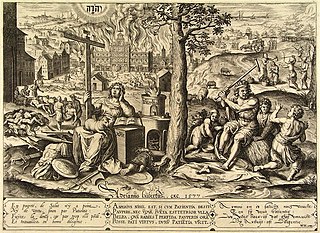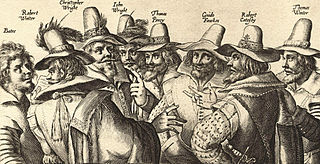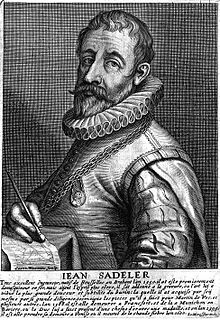
Hans von Aachen was a German painter who was one of the leading representatives of Northern Mannerism.

Cornelis Cort was a Dutch engraver and draughtsman. He spent the last 12 years of his life in Italy, where he was known as Cornelio Fiammingo.

Jan Collaert the Elder or (I), Hans Collaert the Elder or Johannes Collaert (Brussels, between 1525 and 1530 – Antwerp, October 1580) was a Flemish printmaker, publisher, draftsman, tapestry designer, glass painter and designer and engraver of swords. He was the founder of a dynasty of engravers that would play a significant role in establishing Antwerp as one of the leading centres for printmaking in Europe in the second half of the 16th century and the early 17th century.
Events from the year 1570 in art.

Bartholomeus Spranger or Bartholomaeus Spranger was a Flemish painter, draughtsman, sculptor, and designer of prints. Working in Prague as a court artist for the Holy Roman emperor Rudolf II, he responded to his patron's aesthetic preferences by developing a version of the extreme style which has become known as Northern Mannerism. This style stressed sensuality, which was expressed in smoothly modeled, elongated figures arranged in elegant poses, often including a nude woman seen from behind. Spranger's unique style combining elements of Netherlandish painting and Italian influences, in particular the Roman Mannerists, had an important influence on other artists in Prague and beyond as his paintings were disseminated widely through prints.

Jacob Hoefnagel, was a Flemish painter, printmaker, miniaturist, draftsman, art dealer, diplomat, merchant and politician. He was the son of the Flemish painter and miniaturist Joris Hoefnagel (1542–1601) who was a court painter to the dukes of Bavaria and Emperor Rudolf II in Prague. Jacob Hoefnagel himself became a court painter to Rudolf II and to the Swedish court. He is noted for his illustrations of natural history subjects as well as his portraits, topographical views, emblems and mythological works, which continue his father's style.

Maerten de Vos, Maerten de Vos the Elder or Marten de Vos was a Flemish painter. He is known mainly for his history and allegorical paintings and portraits. He was, together with the brothers Ambrosius Francken I and Frans Francken I, one of the leading history painters in the Spanish Netherlands after Frans Floris career slumped in the second half of the sixteenth century as a result of the Iconoclastic fury of the Beeldenstorm.

The Eleven Caesars was a series of eleven painted half-length portraits of Roman emperors made by Titian in 1536-40 for Federico II, Duke of Mantua. They were among his best-known works, inspired by the Lives of the Caesars by Suetonius. Titian's paintings were originally housed in a new room inside the Palazzo Ducale di Mantova. Bernardino Campi added a twelfth portrait in 1562.

Northern Mannerism is the form of Mannerism found in the visual arts north of the Alps in the 16th and early 17th centuries. Styles largely derived from Italian Mannerism were found in the Netherlands and elsewhere from around the mid-century, especially Mannerist ornament in architecture; this article concentrates on those times and places where Northern Mannerism generated its most original and distinctive work.

The Wierix family, sometimes seen in alternative spellings such as Wiericx, were a Flemish family of artists who distinguished themselves as printmakers and draughtsmen in the late 16th and early 17th centuries. They were active in Antwerp and Brussels.

Hieronymus Wierix (1553–1619) was a Flemish engraver, draughtsman and publisher. He is known for his reproductive engravings after the work of well-known local and foreign artists including Albrecht Dürer. Together with other members of the Wierix family of engravers he played an important role in spreading appreciation for Netherlandish art abroad as well as in creating art that supported the Catholic cause in the Southern Netherlands.

Johannes Wierix was a Flemish engraver, draughtsman and publisher. He was a very accomplished engraver who made prints after his own designs as well as designs by local and foreign artists. He further made engravings on silver and ivory.

Crispijn van de Passe the Elder, or de Passe was a Dutch publisher and engraver and founder of a dynasty of engravers comparable to the Wierix family and the Sadelers, though mostly at a more mundane commercial level. Most of their engravings were portraits, book title-pages, and the like, with relatively few grander narrative subjects. As with the other dynasties, their style is very similar, and hard to tell apart in the absence of a signature or date, or evidence of location. Many of the family could produce their own designs, and have left drawings.

Aegidius Sadeler or Aegidius Sadeler II (1570–1629) was a Flemish engraver who was principally active at the Prague court of Rudolf II, Holy Roman Emperor and his successors.

Joos van Winghe, Jodocus a Winghe or Jodocus van Winghen (1544–1603) was a Flemish painter and print designer. He is known for his history paintings, portraits, allegories and genre scenes, including merry companies. He worked in Brussels as court painter and left Flanders after the Fall of Antwerp in 1584. He then worked in Frankfurt for the remainder of his career. In Germany he enjoyed the patronage of Holy Roman emperor Rudolf II and adopted a more clearly Mannerist style.

Hans Speckaert, was a Flemish Renaissance painter who was active in Italy. He is known for his portraits, history paintings and his many drawings. The artist was one of the earliest representatives of Northern Mannerism. His fluid and elegant drawing style exerted an important influence on contemporary Northern artists.

Pieter Stevens II or Peter Stevens II was a Flemish painter and draughtsman known for his landscapes. He left Flanders to work for the court of Emperor Rudolf II in Prague. The circulation of prints made after a series of romantic Bohemian landscape drawings by Stevens and other artists had an important influence on the development of Flemish and Dutch landscape art in the 17th century.

Alexander Voet the Younger or Alexander Voet II was a Flemish engraver, print artist and publisher. He was the son of Alexander Voet the Elder, one of the leading engravers and publishers in Antwerp in the middle and second half of the 17th century. He first worked in his father's large workshop and later operated his own workshop.

Noah's Ark is a tempera painting by Theodore Poulakis. Poulakis was a Greek Baroque painter and teacher. He was a member of both the Late Cretan School and the Heptanese School. He is often regarded as the father of the Heptanese School. He was active from 1635 to 1692. By the age of 24, he was living in Venice. He stayed in the city for thirteen years. He was involved in local politics. He frequently traveled all over the Ionian Islands and settled in Corfu. He also regularly returned to Venice. Over 130 of his paintings have survived and can be found all over the world.

Jacob’s Ladder is a tempera painting created by Elias Moskos. Elias was a Greek painter originally from the island of Crete. By the 1650s he was living on the island of Zakynthos. He also worked on the island of Kefalonia. There were two other painters active during his lifetime with the same last name. Ioannis Moskos and Leos Moskos. The painter was also a prominent teacher. He also had a sizable fortune. Fifty-two of his paintings survived. He represented the Cretan School and the Heptanese School. His works typically combine both schools. His work was heavily influenced by engravings from all over the world some were Flemish. His artistic activity ranged from 1629 to 1687. Most of his remaining works are in Greece and Italy.
























